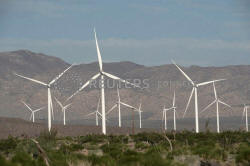|
In
its annual flagship report, the International Renewable Energy
Agency underscored the scale and pace of change needed to cap
the rise in average global temperatures at 1.5 degrees Celsius,
in line with the 2015 Paris climate accord.
"The gap between where we are and where we should be is not
decreasing but widening," said Francesco La Camera,
director-general of the Abu Dhabi-based organisation, which has
more than 160 member states. "We need a drastic acceleration of
energy transitions to make a meaningful turnaround."
The agency's "1.5C pathway" set out in the report found that
fossil fuel consumption would have to fall by more than 75% by
2050, with oil and coal shrinking more quickly.
Use of natural gas would have to peak in 2025, although it would
be the dominant fossil fuel by mid-century.
Renewable power capacity will have to expand more than ten-fold
by mid-century, accompanied by a 30-fold increase in the
electrification of transport, the report found.
It also foresaw a dramatic increase in the production and use of
"green hydrogen" - a zero-carbon fuel made by electrolysis,
using power from wind and solar, that splits water into hydrogen
and oxygen.
By 2050, 30% of electricity use will be dedicated to producing
green hydrogen and hydrogen and its derivatives, such as
e-ammonia and e-methanol, the report said.
To produce this, global electrolyser capacity will need to
expand to almost 5,000 Gigawatts from 0.3 GW today.
The report said governments could still harness post-pandemic
recovery packages, which have so far mostly favoured fossil
fuels, to accelerate the transition.
(Reporting by Matthew Green; Editing by Dan Grebler)
[© 2021 Thomson Reuters. All rights
reserved.] Copyright 2021 Reuters. All rights reserved. This material may not be published,
broadcast, rewritten or redistributed.
Thompson Reuters is solely responsible for this content.

|
|





